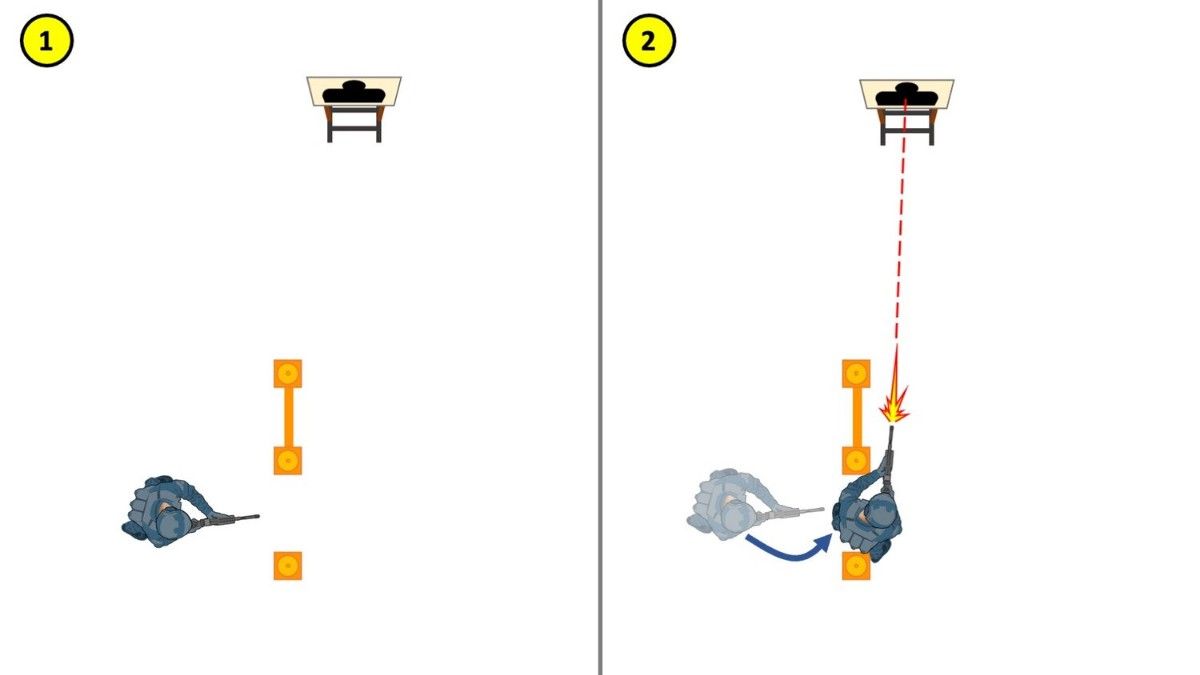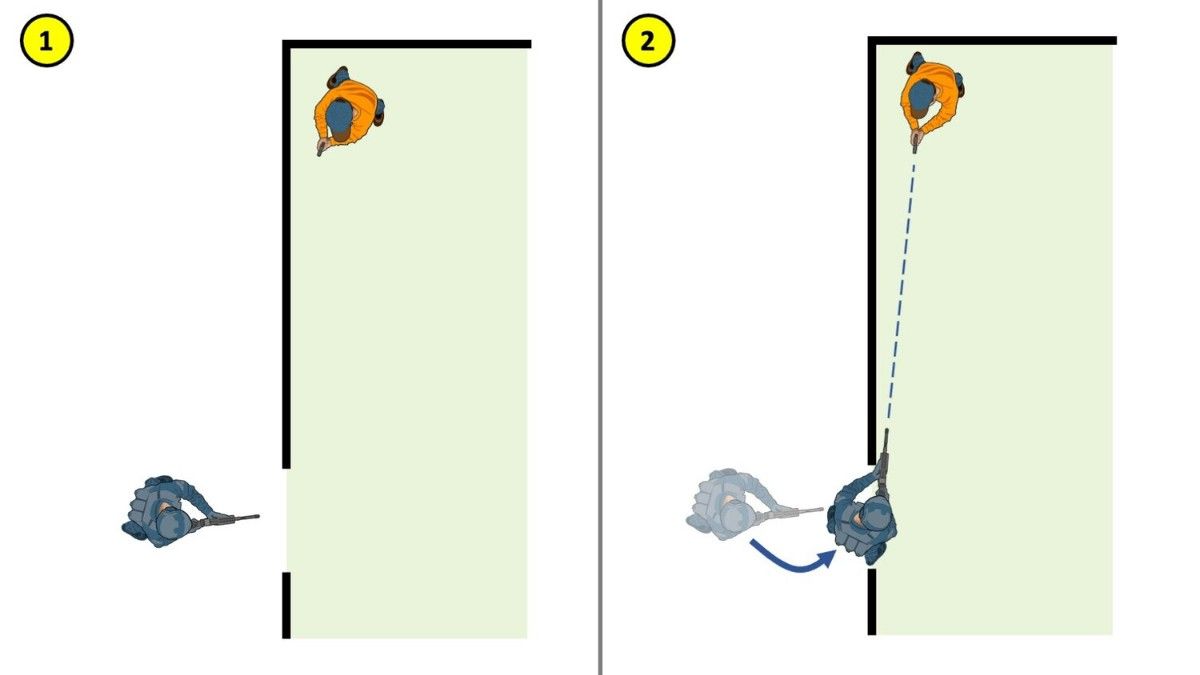Advanced CQB: How to Train Footwork
Advanced Close Quarters Battle (CQB): How to Train Your Footwork
Learning or understanding new close quarters battle (CQB) footwork techniques may still not mean you are able to apply those techniques effectively in a high-stress situation. Mastering footwork requires much practice. The quality of your practice is even more important than your quantity of practice.
In this article, we cover some training/practice techniques for optimizing and refining your CQB footwork. For demonstration purposes, we'll focus here on the footwork explained in the previous article, “Advanced Close Quarters Battle (CQB): Footwork 1 - Turn Right, Turn Left.”
Let's review a variety of drills you can utilize to aid in your refinement, improvement, and mastery of close quarters battle (CQB) footwork techniques.
In this article, we cover some training/practice techniques for optimizing and refining your CQB footwork. For demonstration purposes, we'll focus here on the footwork explained in the previous article, “Advanced Close Quarters Battle (CQB): Footwork 1 - Turn Right, Turn Left.”
Let's review a variety of drills you can utilize to aid in your refinement, improvement, and mastery of close quarters battle (CQB) footwork techniques.
DRILL 1 – Minor Variations
The easiest way to begin refining and improving your CQB footwork is to practice a technique multiple times, making slight variations in your movement as you experiment with various options. At this point you are just going by feel - not yet trying to measure or quantify your performance.
What is most comfortable for you? Which variation is smoothest, fastest and most fluid?
For example, you may want to try planting your weak foot closer to the door to see how that affects the movement. Then, try planting your foot further away and notice the difference in how the movement feels. Continue experimenting by adjusting your approach between a steeper angle and a more head-on angle. How does this impact your movement and the flow of the technique?
Through practice and experimentation you will begin to identify variations that are more comfortable, fluid and natural to quickly execute. Continue refining these variations until the movement starts to become second nature.
What is most comfortable for you? Which variation is smoothest, fastest and most fluid?
For example, you may want to try planting your weak foot closer to the door to see how that affects the movement. Then, try planting your foot further away and notice the difference in how the movement feels. Continue experimenting by adjusting your approach between a steeper angle and a more head-on angle. How does this impact your movement and the flow of the technique?
Through practice and experimentation you will begin to identify variations that are more comfortable, fluid and natural to quickly execute. Continue refining these variations until the movement starts to become second nature.
Write your awesome label here.
Single Person Close Quarters Battle (CQB) Training Course
This training will teach you the fundamentals of how to move, fight, and survive as an individual in a variety of combat, defensive, and emergency scenarios. A companion training manual is also available.
DRILL 2 – Range Application
Once you have a basic grasp on how you prefer to conduct a given movement, it is critical to try out that movement on the range with real bullets before you deeply ingrain that movement in muscle memory. A live fire element may significantly change how the movement feels. Moving a certain way may feel fine when you’re not actually shooting, but become uncomfortable or awkward when you incorporate a live weapon. Therefore, you must practice all movements using real bullets relatively early in the learning process.
For safety reasons, we caution against practicing movements in a live-fire shoot house environment early on.
It is cheaper, simpler, and safer to create some markings on the range using cones, engineer tape, surveyors’ tape, spray paint, etc. and practice the movement while shooting at a static steel or paper target.
For example, to practice moving through the door and turning left or right, set up a notional door frame perpendicular to the firing line (see image below) and practice the entry footwork repeatedly, engaging a single target in the notional “corner” as you enter.
It is cheaper, simpler, and safer to create some markings on the range using cones, engineer tape, surveyors’ tape, spray paint, etc. and practice the movement while shooting at a static steel or paper target.
For example, to practice moving through the door and turning left or right, set up a notional door frame perpendicular to the firing line (see image below) and practice the entry footwork repeatedly, engaging a single target in the notional “corner” as you enter.

Practicing close quarters battle (CQB) entry footwork techniques using a notional doorway.
Some ranges may prohibit change of direction drills or pivot/turn drills, so be sure to check with the range staff or range safety officer to fully understand the range safety regulations and procedures.
Always ensure your weapon is pointed in a safe direction - especially when moving - and keep the weapon on safe until you are ready to fire. In some cases you may need to lower the weapon prior to the turn.
Whenever possible, practice the techniques at the edge of the range so you have berms to both your front and your side to maximize safety.
An additional consideration to be mindful of when executing this drill: depending on range regulations, you may be required to stop once you enter the “room” and make your turn. Depending on which entry technique you use, this mid-technique interruption can create “training scars” - which might lead you to stop unintentionally when entering a room in a high-stress situation because that is the way you repeatedly practiced the technique. To help minimize this risk, whenever possible execute your full entry technique as you would in a real-world situation. If that is impossible, include periodic dry-fire entry practice at a safe distance from the firing line.
Always ensure your weapon is pointed in a safe direction - especially when moving - and keep the weapon on safe until you are ready to fire. In some cases you may need to lower the weapon prior to the turn.
Whenever possible, practice the techniques at the edge of the range so you have berms to both your front and your side to maximize safety.
An additional consideration to be mindful of when executing this drill: depending on range regulations, you may be required to stop once you enter the “room” and make your turn. Depending on which entry technique you use, this mid-technique interruption can create “training scars” - which might lead you to stop unintentionally when entering a room in a high-stress situation because that is the way you repeatedly practiced the technique. To help minimize this risk, whenever possible execute your full entry technique as you would in a real-world situation. If that is impossible, include periodic dry-fire entry practice at a safe distance from the firing line.
DRILL 3 – Range Performance Assessment
When you have practiced the movement while shooting on the range to the point where you feel comfortable and safe, you can start measuring and tracking your performance.
Go back to making minor adjustments to your footwork and stance; observe how they affect your speed and accuracy. Record your shot accuracy and/or shot speed while performing a set of five to ten repetitions using a single variation or adjustment to your footwork.
It is helpful when recording accuracy to take digital pictures of your target after each set and make some written notes to keep track of which shot groups relate to each footwork variation. Again, it is useful to conduct a complete “set” with multiple repetitions to ensure your data is accurate.
You can use a simple shot timer for measuring speed. Position yourself where you are just about to break the doorway plane and turn into the room. Activate your shot timer and execute the turn on the sound of the buzzer. Conduct a complete set of repetitions and record your times.
Time and accuracy often have an inverse relationship, so it can be useful to record both. Remember, the point of these sets is not to see how accurate and how fast you can be. Rather, you seek to identify which footwork variations and patterns maximize your performance.
To achieve optimal results, you should continually experiment with different techniques and analyze the data. There is always room to improve.
Go back to making minor adjustments to your footwork and stance; observe how they affect your speed and accuracy. Record your shot accuracy and/or shot speed while performing a set of five to ten repetitions using a single variation or adjustment to your footwork.
It is helpful when recording accuracy to take digital pictures of your target after each set and make some written notes to keep track of which shot groups relate to each footwork variation. Again, it is useful to conduct a complete “set” with multiple repetitions to ensure your data is accurate.
You can use a simple shot timer for measuring speed. Position yourself where you are just about to break the doorway plane and turn into the room. Activate your shot timer and execute the turn on the sound of the buzzer. Conduct a complete set of repetitions and record your times.
Time and accuracy often have an inverse relationship, so it can be useful to record both. Remember, the point of these sets is not to see how accurate and how fast you can be. Rather, you seek to identify which footwork variations and patterns maximize your performance.
To achieve optimal results, you should continually experiment with different techniques and analyze the data. There is always room to improve.
DRILL 4 – Coach/Partner Feedback
Any of these drills can be even more effective when practiced with a partner or coach.
Practice a technique together, alternating iterations. While one person is performing the technique, the other is observing and assessing. After each repetition, the person who just fired should conduct a self-assessment to identify what he did well and what he could have done better.
The observer should follow up with additional evaluations, comments, and suggestions. In doing this, it is critical that the peer feedback be as honest and open as possible.
Ego is among the biggest enemies to performance enhancement. Be willing to offer constructive criticism and point out mistakes. You do each other no favors by overlooking mistakes and trying to be “nice.” Of course, don’t be resistant to constructive criticism yourself. Avoid making excuses; simply listen carefully to your partner’s feedback. After considering the feedback, you can offer your own counter arguments or opinions.
The more both sides collaborate to generate a constructive dialogue, the better the training will be.
Practice a technique together, alternating iterations. While one person is performing the technique, the other is observing and assessing. After each repetition, the person who just fired should conduct a self-assessment to identify what he did well and what he could have done better.
The observer should follow up with additional evaluations, comments, and suggestions. In doing this, it is critical that the peer feedback be as honest and open as possible.
Ego is among the biggest enemies to performance enhancement. Be willing to offer constructive criticism and point out mistakes. You do each other no favors by overlooking mistakes and trying to be “nice.” Of course, don’t be resistant to constructive criticism yourself. Avoid making excuses; simply listen carefully to your partner’s feedback. After considering the feedback, you can offer your own counter arguments or opinions.
The more both sides collaborate to generate a constructive dialogue, the better the training will be.
DRILL 5 – Force-on-Force
The real test comes with force-on-force training and testing against a live, thinking adversary. You can conduct force-on-force drills with dry fire, laser devices, realistic airsoft training weapons, or with training ammunition such as Simunition or UTM.
While realistic training weapon systems or training ammunition is ideal, you can make great progress even using dry fire. For example, when practicing turning left or right to enter a room, have your partner stand in the corner pretending to be an enemy. For obvious safety reasons, be sure to use dummy (orange/red/blue/etc.) weapons.
Your partner should begin with his weapon lowered. As you enter the room, he should raise the weapon and attempt to engage you. The purpose of this drill is to see if you can engage your partner before he can target you. Some dummy weapons (like SIRT pistols) have functional triggers, which can provide an audible or visible cue to identify who pulled the trigger first.
If your movement and footwork are good, fluid and fast enough, you should consistently beat your partner to the shot. If not, keep practicing and refining your movements to improve your performance.
Caution: when using lasers in force-on-force, be certain to never shine the laser at your partner’s face. Always aim for center-mass.
While realistic training weapon systems or training ammunition is ideal, you can make great progress even using dry fire. For example, when practicing turning left or right to enter a room, have your partner stand in the corner pretending to be an enemy. For obvious safety reasons, be sure to use dummy (orange/red/blue/etc.) weapons.
Your partner should begin with his weapon lowered. As you enter the room, he should raise the weapon and attempt to engage you. The purpose of this drill is to see if you can engage your partner before he can target you. Some dummy weapons (like SIRT pistols) have functional triggers, which can provide an audible or visible cue to identify who pulled the trigger first.
If your movement and footwork are good, fluid and fast enough, you should consistently beat your partner to the shot. If not, keep practicing and refining your movements to improve your performance.
Caution: when using lasers in force-on-force, be certain to never shine the laser at your partner’s face. Always aim for center-mass.

Force-on-force training and testing against a live, thinking adversary using simulated weapons systems or training ammunition.
DRILL 6 – Using Video
You can video record any of the drills discussed above or elsewhere. Video can significantly improve your ability to self-assess and improve.
For example, when conducting live-fire or dry-fire movements, place a camera in the corner of the room to review your movement from the adversary’s point of view. This will let you see if you are exposing your muzzle or shadow before breaking the plane of the door.
Videos are even more useful when you slow them down to examine movements in detail. A camera with a high frame rate can significantly increase the quality of slow-motion playback.
A telescoping tripod would allow you to easily move the camera around and adjust its angle. If you have multiple cameras, try recording your movement from several angles and then perform a detailed assessment.
When working with a partner, review the videos together, comparing both of your movements and discussing ways to improve.
You can also use helmet/head cameras to incorporate video into force-on-force drills, enabling you to see the action from both your perspective and your adversary’s perspective.
Save the videos and label them with dates and notes to record and monitor your improvement over time.
For example, when conducting live-fire or dry-fire movements, place a camera in the corner of the room to review your movement from the adversary’s point of view. This will let you see if you are exposing your muzzle or shadow before breaking the plane of the door.
Videos are even more useful when you slow them down to examine movements in detail. A camera with a high frame rate can significantly increase the quality of slow-motion playback.
A telescoping tripod would allow you to easily move the camera around and adjust its angle. If you have multiple cameras, try recording your movement from several angles and then perform a detailed assessment.
When working with a partner, review the videos together, comparing both of your movements and discussing ways to improve.
You can also use helmet/head cameras to incorporate video into force-on-force drills, enabling you to see the action from both your perspective and your adversary’s perspective.
Save the videos and label them with dates and notes to record and monitor your improvement over time.
In Conclusion
As you see, there are many ways to take your close quarters battle (CQB) footwork training to the next level to refine and enhance your performance, even when practicing a movement as basic as entering a room and turning to the right or left.
The crucial point to remember is that you can always improve, and you should continuously strive to do so. That doesn’t mean only improving your footwork, speed, and accuracy. It also means improving the way you train and the way you measure and assess your performance and training methodology. It is also important to share your techniques and ideas with others and to exchange notes on best practices.
The crucial point to remember is that you can always improve, and you should continuously strive to do so. That doesn’t mean only improving your footwork, speed, and accuracy. It also means improving the way you train and the way you measure and assess your performance and training methodology. It is also important to share your techniques and ideas with others and to exchange notes on best practices.
©Copyright Special Tactics, LLC. All rights reserved.
Iron Survival, LLC
Featured links
Policy Pages
©Copyright 2026 Iron Survival, LLC
